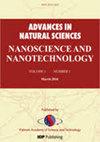Hetero-epitaxial grown Pt@Au core-shell bimetallic nanoparticles on reduced graphene oxide (RGO) as electrocatalyst for oxygen reduction reaction in alkaline media
IF 1.7
Q3 MATERIALS SCIENCE, MULTIDISCIPLINARY
Advances in Natural Sciences: Nanoscience and Nanotechnology
Pub Date : 2024-01-17
DOI:10.1088/2043-6262/ad1a9d
引用次数: 0
Abstract
The core-shell structured Pt@Aubimetallic nanoparticles (NPs) were decorated on the reduced graphene oxide (RGO) surface by a heteroepitaxial growth method. The morphological details of Pt@Au/RGO core/shell bimetallic NPs were assessed by high-resolution transmission electron microscopy (HR-TEM), x-ray diffraction (XRD), and energy-dispersive x-ray spectroscopy (EDS). Electron microscopy results revealed that Pt@Au particles of 3.4 nm were firmly attached to RGO sheets. The electrochemical response of Pt@Au/RGO nanostructured electrocatalyst was measured through cyclic voltammetry (CV) at room temperature in 0.1 M KOH solution. Oxygen reduction reaction (ORR) efficacies of Pt@Au/RGO were evaluated by linear sweep voltammetry (LSV) by rotating catalyst-coated glassy carbon (GC) electrode at different rotation speeds in oxygen saturated 0.1 M KOH solution. The electrochemical activity descriptors (half-wave potential, onset potential, limiting current density) were assessed from ORR polarisation curves. The results revealed that Pt@Au/RGO bimetallic NPs showed enhanced higher catalytic activity towards ORR compared to commercial Pt/C catalyst as well as similarly synthesised Pt/RGO and Au/RGO. The enhanced catalytic activity of Pt@Au/RGO electrocatalyst might result from the core/shell structure with a tiny Pt core and a thin Au shell, as well as the synergistic effects of Au and Pt.还原型氧化石墨烯 (RGO) 上异质外延生长的 Pt@Au 核壳双金属纳米粒子作为碱性介质中氧还原反应的电催化剂
采用异质外延生长法在还原氧化石墨烯(RGO)表面装饰了核壳结构的 Pt@Aubimetallic 纳米粒子(NPs)。通过高分辨率透射电子显微镜(HR-TEM)、X 射线衍射(XRD)和能量色散 X 射线光谱(EDS)评估了 Pt@Au/RGO 核/壳双金属 NPs 的形态细节。电子显微镜结果显示,3.4 nm 的 Pt@Au 颗粒牢固地附着在 RGO 片上。室温下,在 0.1 M KOH 溶液中,通过循环伏安法(CV)测量了 Pt@Au/RGO 纳米结构电催化剂的电化学响应。在氧气饱和的 0.1 M KOH 溶液中,以不同的转速旋转涂有催化剂的玻璃碳(GC)电极,通过线性扫描伏安法(LSV)评估了 Pt@Au/RGO 的氧还原反应(ORR)效率。根据 ORR 极化曲线评估了电化学活性描述因子(半波电位、起始电位、极限电流密度)。结果表明,与商用 Pt/C 催化剂以及类似合成的 Pt/RGO 和 Au/RGO 相比,Pt@Au/RGO 双金属 NPs 在 ORR 方面表现出更高的催化活性。Pt@Au/RGO 电催化剂催化活性的增强可能是由于其具有微小的铂核和较薄的金壳的核/壳结构,以及金和铂的协同效应。
本文章由计算机程序翻译,如有差异,请以英文原文为准。
求助全文
约1分钟内获得全文
求助全文
来源期刊

Advances in Natural Sciences: Nanoscience and Nanotechnology
NANOSCIENCE & NANOTECHNOLOGYMATERIALS SCIE-MATERIALS SCIENCE, MULTIDISCIPLINARY
自引率
4.80%
发文量
0
 求助内容:
求助内容: 应助结果提醒方式:
应助结果提醒方式:


